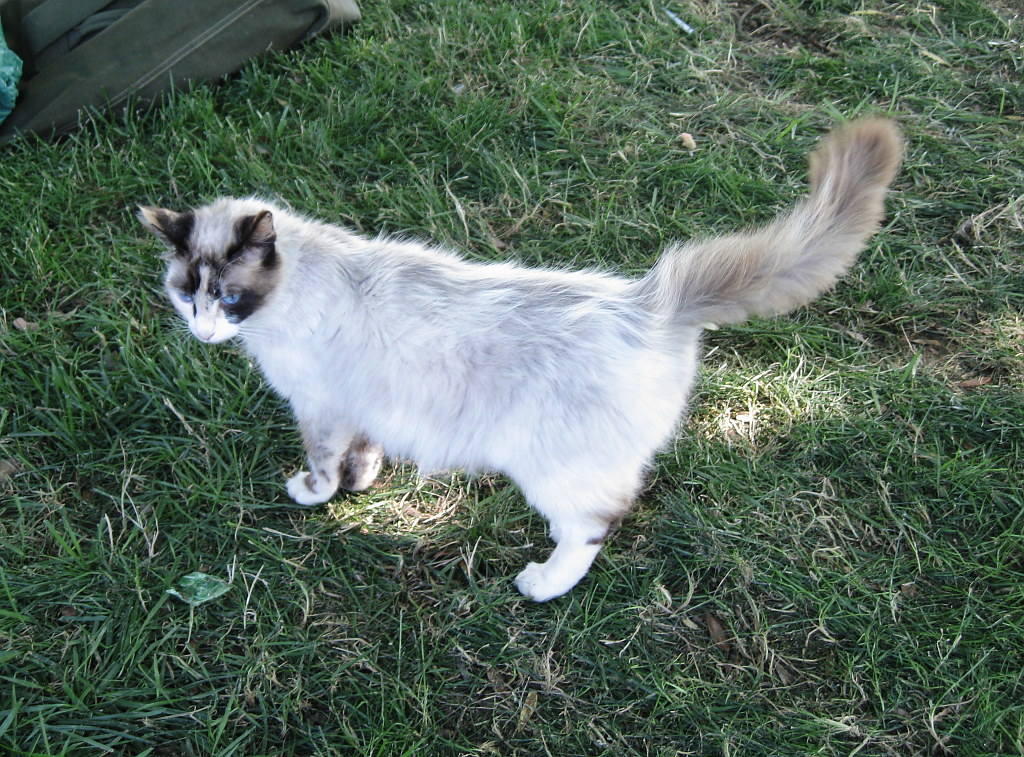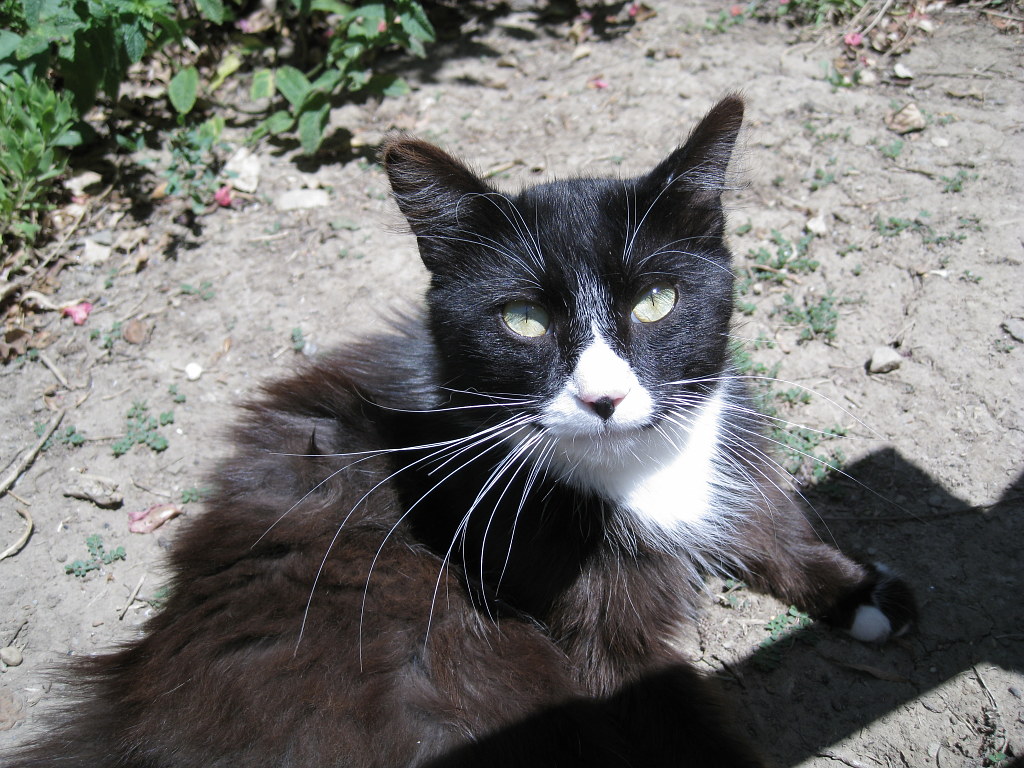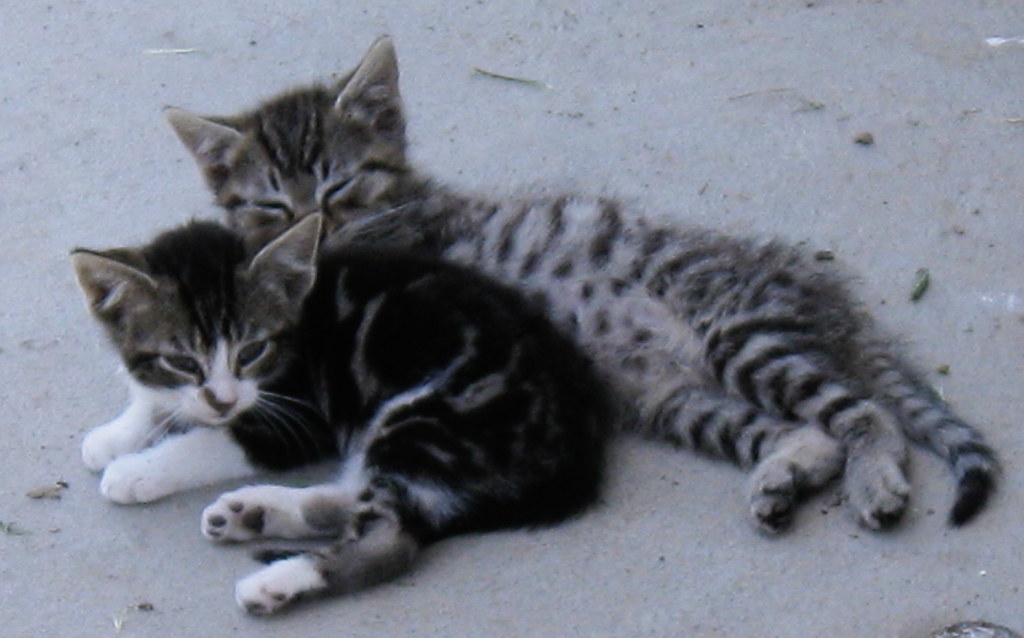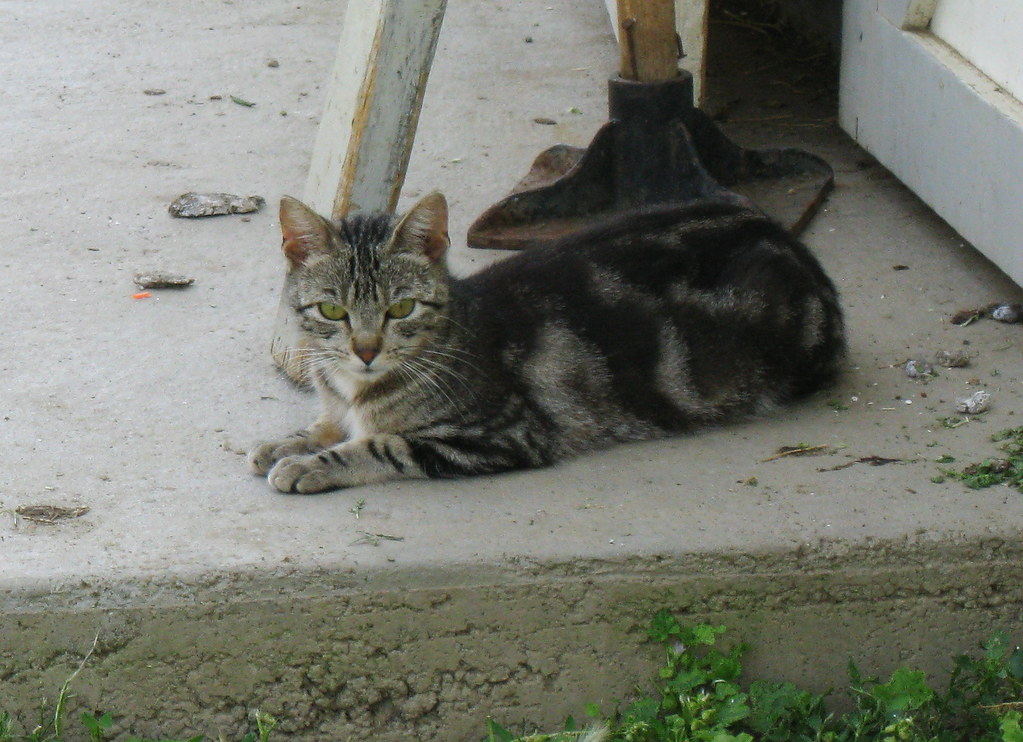According to the farm-resident relatives, there are actually something like 40 cats (!!!) living on the property, a population consisting of about half kittens and half adult cats. I did not see all these cats personally, but I did not expect to, seeing as we were there during afternoon hours (a.k.a. naptime for kitties) and the place was huge (meaning there were lots of potential hiding and secluded sleeping spots).
The first cat I met, pictured below, is named Diamond. Matt's mom was actually holding her when Matt and I walked up to the picnic area.

She was extremely curious, social with humans (and dogs, and other cats), and persistent -- eventually one of the younger cousins was told to go put her in the barn because she kept jumping on the picnic tables and trying to stick her nose in the chip-dip. But she got out of the barn easily. Hee. And she was also one of the most unique-looking cats I've ever seen: small (she was about a year old and probably weighed about six pounds) but with a feathery Maine Coon-ish tail, blue eyes, light-colored body, and "tortie point" coloration.
Diamond is now spayed but she did have a litter of kittens a few months ago. Matt is shown holding two of them: a little marmalade boy named OnyxTiger and a calico girl whose name I unfortunately cannot recall.

Like their mother these little ones were very sweet and inquisitive, though the girl kitten was quite a bit more adventurous. When I was holding her she sort of tried to climb up the back of my neck and probably would have ended up IN my backpack if the zipper had been open. Reminded me a lot of Cora in that regard!
Diamond's brother Mooglu (was originally going to be "Mowgli" but the kids kept saying "Mooglu" and it stuck) was similarly curious about all the strange humans gallivanting around. He hung out and watched the festivities from the porch or front garden most of the time. He was about Diamond's size (must be a "small cat gene" in that population) and a very handsome tuxedo brownish-black-and-white.

These two young kittens were lounging out by the barn most of the day. They don't have names yet.

This pretty marble tabby girl is called Pocahontas.

And then there was this little grey fellow -- a very young kitten, probably no more than 3 or 4 weeks old.

When I first saw him something definitely seemed weird about the situation because it is not often you see a kitty that young without his mama. He was just sitting on one edge of the concrete platform thing at the barn entrance all by himself. I went over to let him sniff my finger (a cat greeting that is more polite, IMO, than just going up and petting them) and he did so. But when I got close to him I saw that his eyes were fused shut!
I thought at first maybe he was REALLY young and his eyes just were not open yet, however it turned out that he had some sort of eye infection that was causing his eyelids to stick. Kittens' eyes should be open by around 9 days and (tiny as he was) he was definitely older than that. I also learned that he was apparently the sole survivor of a litter that had been very sickly from the start, and that the mother kitty (who I did not see) had not been very attentive. Just as with humans, not all cats necessarily have the best parenting skills. And while Little Grey Kitten was apparently being sporadically nursed by another female cat, he was definitely not getting enough milk to thrive on. Kittens are supposed to have fat little round bellies and this little guy just felt like fur and air.
But! The day had somewhat of a happy ending for Little Grey Kitten, because another relative at the picnic (who I briefly spoke to -- she was definitely a Cat Person) got permission from the farm-folks to take him home with her, where she would be able to bottle-feed him, get him antibiotics for his eyes, etc. I really hope he pulls through, and I am SO glad there was someone else in attendance whose household cat-carrying capacity was not at its limit (as mine is with four felines-in-residence).
I would guess that most modern humans who did not grow up in farm-type settings and who've known cats primarily in the "companion" context might find the life of a barn cat to be quite unusual, perhaps even disconcerting. These are definitely not "kept" cats. They face some very harsh realities, such as the fact of being not just predators in the rural zones they inhabit, but prey for coyotes and the like. Aside from rabies vaccines, they probably rarely see the vet; sick barn cats either get better on their own or "disappear" as they succumb to illness. Most of them have a few fleas here and there, and this is not considered a big deal.
However, they have a lot more autonomy and freedom to come and go than the average house-cat. And their lifestyle certainly permits them to constantly engage in normal feline activities (hunting, territory-marking, etc.) without human interference or scolding. Some of them are spayed or neutered, of course, but not all, as (due to the aforementioned coyote predation issue) the farm-folks want to assure there are enough cats at any given time to properly deal with crop-threatening rodent pests.
Furthermore, these cats looked tremendously happy; trotting around the farm, eyes bright and sparkling, tails aloft like banners, greeting humans, dogs, and other cats alike with purrs and face-rubs. They also, aside from the aforementioned miscellaneous flea, looked to be extremely healthy: lean (but not too skinny) and glossy-furred.
Of course housecats can be, and often are, just as happy and healthy. Most will not wander far even if allowed outside, and hence I would certainly not consider them to categorically be "prisoners"; cats are territorial and tend to get very attached to places, after all. And there are ways to provide cats with plenty of human-acceptable outlets for necessary feline actions in human homes and suburban yards. My point here is hence not to suggest that either the housecat life or the barn cat life is fundamentally "better", but rather, to express considerable awe at the impressive adaptability of cats.
We humans call them "domestic" felines, however it seems clear to me that cats can do very well in any number of situations. It is almost as if they have a number of different "programs" they can potentially run depending on their early life circumstances. It rather amazes me to consider that the silent feral cat who only comes to the food bowl at night when humans aren't around, the super-socialized housecat riding around on her human's shoulder, and the friendly-but-scrappy mouser-extraordinaire barn cat are, genetically speaking, members of the same species.
Moreover, having observed cats in all these settings, I find myself amazed even further at the way each sort of life can be equally rich despite every path looking so radically different from every other. Of course I am not saying that it doesn't matter at all how we (humans) treat cats, so hopefully it does not come across that way. But I think there is a difference between treating someone ethically and respectfully, and trying to prescribe a particular sort of life for every member of a given species as the only possible acceptable one.

No comments:
Post a Comment
This blog has been archived and can no longer receive comments.
Note: Only a member of this blog may post a comment.